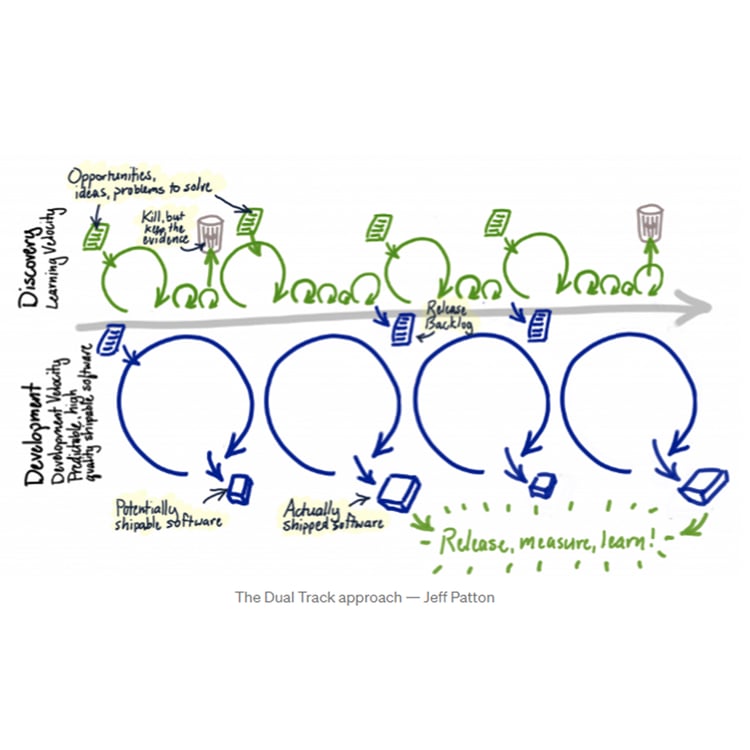
Are you building the right product? Are product discovery team members sharing what they’re learning with the rest of the development team? If you’re not sure, then maybe Dual Track is for you.
So, what is Dual Track? Simply put, Dual Track is about bringing light to product discovery by focusing on generating and validating product ideas for the team’s delivery backlog. It does this by bringing the product Discovery work into visibility.
You may be thinking like me, what’s the big deal? When we practice Scrum, we have the Product Owner work with stakeholders, including UX, to build a backlog. The problem is that they often do this work in a silo and only share their stories with delivery team members at Sprint Planning. If your team sees stories for the first time at Sprint Planning, it’s too late. So, in Dual Track, we have visibility into the work the PO and the discovery team members are doing, and this work is shared on a regular cadence with the rest of the team in refinement, or through team members working together.
Dual Track is nothing new. The original idea was published in 2007 by Desiree Sy, and Marty Cagan wrote about it in 2012. While there are many instances of writings about Dual Track, Jeff Patton and Marty Cagan are two of the most well-known advocates for what Marty has coined Dual Track Scrum. In its simplest form, Dual Track provides visibility and best practices to the discovery work that must occur before a team ever sees a user story. A good article to read more by Jeff Patton can be found here.
While researching Dual Track, I found that it fits nicely with what I believe the Product Owner, Business Analyst, and UX people on the team should be doing anyway. That is working with stakeholders and the team to discover the best product. Dual Track emphasizes team engagement and focuses on not letting people work in silos. It provides guidance and structure to ensure the entire team builds the right products at the right time, together as one team. So here is one of the first things I discovered about Dual Track – the team performs as one team. Read on to see what else I discovered.
One Team, One Backlog, One set of Scrum events
According to Jeff Patton, Dual Track is “just two parts of one process”. It focuses on maximizing the value delivery of your entire team by having discovery team members working a Sprint ahead of the development (delivery) team members and including them in the work.
This approach to embracing one team is important; as Jeff Patton says, “the whole team is responsible for product outcomes, not just on-time delivery”. When we keep the entire team engaged in product discovery, the developers, and testers will have more context, and they may also surprise us in ideation with great problem solutions. Finally, not all ideas in the backlog should be implemented, and developers can help Product Owners see where ideas will be problematic.
Jeff outlines how to incorporate the product design team members into each Scrum event without disruption. The team works as one, from the Daily Standup to the Sprint Retrospective. A benefit of following a Dual Track is better engagement from developers and faster learning.
Below is a good video link I found on how to set up a single backlog in Jira for Dual Track boards that enables teams to visualize the work they are doing in the two tracks:
Progress on both tracks happens simultaneously
The Discovery Track represents teamwork through product ideation via stakeholder interviews, developing personas and stories, and market research. Once complete, the discovery team members share their findings with the rest of the team. The design team members utilize design sprints to make progress on stories for Sprint N+1, while the development team members are working on Sprint N in delivery sprints. The output from product discovery becomes the input for product delivery. At the same time, feedback from product delivery informs product discovery.
Benefits of Dual Track
The Discovery Track is always a few steps ahead of the delivery team. This approach leads to:
- Better Products – Allowing only validated product ideas into the backlog leads to better products for your customers.
- Less Wasted Time – Breaking the barrier between product design and development means the whole team better understands what they are building, reducing the back-and-forth conversations that occur.
- Lower Development Costs- Teams will not pursue product features that haven’t been validated or are well-thought-out.
Summary
Dual Track increases the odds that you will deliver high-quality products that your customers will love. It does this by bringing visibility to what Product Owners are doing to prepare for a Sprint. It requires high collaboration between the people responsible for ideation and the people responsible for development. If you decide to incorporate Dual Track and design Sprints, you’ll be in good company. Jake Knapp wrote about Google Ventures utilizing design Sprints, and now we have the likes of Uber, Slack, and Facebook embracing this way of working.
I like what I’ve read about Dual Track and hope I have piqued your curiosity. I would love to hear about your experience with Dual Track if you have tried it. Please feel free to share in the comments!
More from the blog
View All Blog PostsSubscribe to Our Blog
Fill out your email address to receive notifications about new blog posts from CC Pace!

